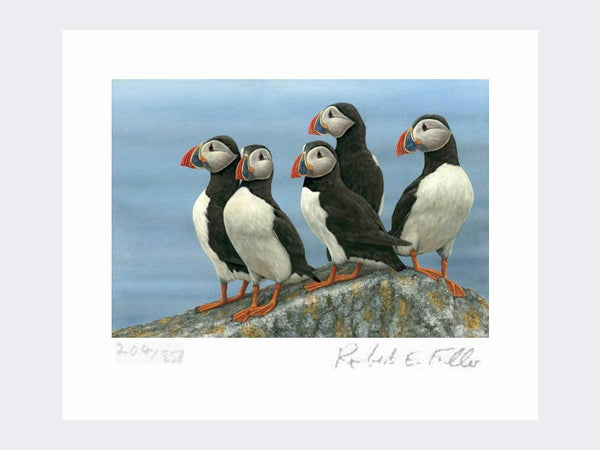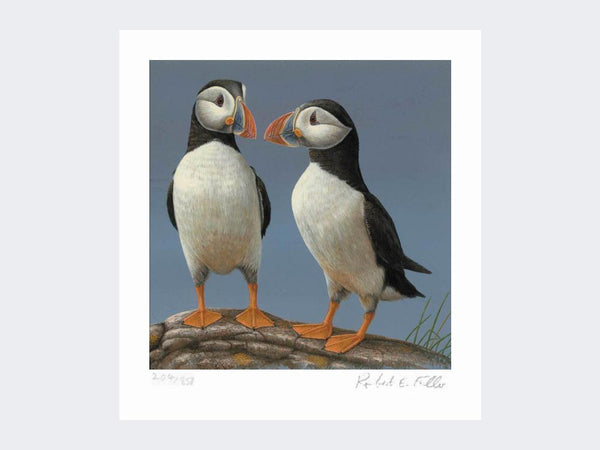Puffins are everybody's favourite seabird and it's not hard to see why. With their smart black and white plumage, comical walk and bright orange beaks, these small birds really stand out. Courting Puffins | Limited Edition Print | Available Here
Courting Puffins | Limited Edition Print | Available Here
Puffins in art
As an artist I love puffins for their exquisite striped bills, edged with shades of blue, grey, red, orange, yellow and cream. Their dark eyes off-set this colourful beak with coordinated red and blue eyeliner. It's as though these birds are asking to be painted - even their orange legs and feet are so bright they reflect a tango glow onto the puffin’s white belly. Scroll down to see the paintings these colourful birds have inspired and to watch a longer video on how my sightings inspire each composition.
Where I go to watch puffins for my paintings
The nearest puffin colony to my gallery is at Bempton Cliffs. From these spectacular chalk sea cliffs it’s possible to watch puffins from the moment they arrive in late April. And they are great to watch. First small dots appear on the horizon. These rapidly increase in size, then small whirring wings and a splash of colour become apparent – that’s when you know that the puffins are back. Once you’ve spotted one, you then see another and another. They gather up into a raft of puffins on the water, before braving it onto the cliffs.
These birds have been at sea for seven months and can be nervous at first. But they soon get into the swing of it and after being away so long it's as though they’re keen for a good catch up on all the gossip. They seem so sociable it is a joy to watch them as they busily meet and greet. Photo Fun Fact: Did you know that when they are not breeding puffins turn a drab grey and look so different that in the 1800s they were thought to be a different species?
Photo Fun Fact: Did you know that when they are not breeding puffins turn a drab grey and look so different that in the 1800s they were thought to be a different species?
Puffins are not always so colourful
Interestingly, puffins return to shore wearing their full breeding plumage and so we think of them as always being in Technicolor. But in winter, whilst away at sea, they undergo a dramatic dressing down and become unrecognisable - with grey faces, dull bills and insipid yellow legs. In fact, their appearance is so different that they were thought to be a different species in the 1800s.
Puffins Get Ready to Breed
Some puffins have already done much of their courtship at sea and get straight down to spring cleaning or digging an underground burrow to nest in when they arrive. These nests are usually three-foot long, and they dig them using their beaks as pickaxes and their feet as shovels. Others still need to find a mate and somewhere to nest.
Puffin Fights
Competition can be fierce and fights break out for burrow ownership. Their beaks can lock and they use their wings as boxing gloves. An aggressive encounter between two puffins often begins by gaping. This involves a puffin puffing up its body to look bigger and opening its beak and wings slightly. The wider the beak: the more upset the puffin. I've seen one stamp its foot in dramatic indignation.
Puffin Love
In contrast, puffins have a very endearing courtship display in which the pair rub their beaks together excitedly and offer one another gifts of grass pulled from the cliff banks. Known as ‘billing’ the beak rubbing action often attracts a rowdy crowd of puffin ‘onlookers’ and invariably fights break out amongst jealous males.
Pufflings Hatch
By May, things have quietened down as each puffin pair incubates a single egg. The chicks or ‘pufflings’ fledge at night and so it is rare to see one. The only way you know they have hatched is when you see the parents ferrying beaks full of sand eels down the burrows to where their chicks are safely hidden. By June you start to see the adults with beaks full of sand eels.
Puffin Catch
Puffins have been recorded carrying over 60 sand eels at once in their beaks that are especially adapted for the job. They can trap fish between backward facing spines in their top bill and hold them there with their spiny tongues, leaving the lower bill free to catch more – ingenious! This gives puffins the edge over both of their closest relatives. Razorbills can only hold a few fish in their beaks at a time and guillemots can only catch one fish at a time, before they have to fly back to feed their chicks.
Once the chicks have hatched the colony starts to get busy again. Puffins seem to come and go from the colony in swathes. This is for good reason. Being one of the smallest seabirds they are very vulnerable to attacks.
Protecting the Pufflings
They fly in swathes, hoping to bamboozle their worst enemy, the greater black backed gull. With a six-foot wingspan, this gull can snatch puffins on the wing. Lesser backed blacked gulls are a real threat as they can actually kill and eat an adult puffin. If a puffin is under attack from one of these, it will immediately drop its catch to divert the bigger bird’s attention.
Luckily for my local puffins, black backs don’t breed at Bempton. But then again these puffins also have to contend with herring gulls. These gulls are unable to take on a full-grown puffin, but will harass one into dropping its hard-earned catch and routinely mug them. I once saw a herring gull pull a puffin’s leg, knocking it out of balance so that it dropped its catch and I've seen one puffin dive down the wrong hole in its rush to escape and then emerge, sheepishly, at the entrance, only to be set upon by gang of gulls that brutally ripped its catch from its beak.
The Story Behind this Puffin Painting
I once watched a gull land amongst them a group of puffins. All the puffins, bar one brave soul, immediately scattered. For an anxious few moments this brave puffin held its ground. The herring gull walked right up to it and looked menacingly down its beak at the puffin, which was a fraction of its size. At that, the puffin rocked back on its heels momentarily before fleeing. I was so tickled by the encounter I painted the scene and named my picture, shown above, Size Matters.
When to See Puffins
You can see puffins at their colonies from late April to August, but June and July are the best months to see them as at this time they are busy feeding their single chick.
How to see Puffins
The puffins at RSPB Bempton Cliffs tend to nest in crevices in the cliffs which they share with some 200,000 seabirds, including the largest mainland gannet colony in the UK. The charity runs three-hour-long ‘Puffin Cruises’ Bridlington Pier throughout the season. You can book your place by telephone on (see 01262 851179 |bempton.cliffs@rspb.org.uk).
Further north, off the coast of Northumberland, are the Farne Islands where you can get a really close look at the 40,000 puffins nesting there. The Farnes are also a great place from which to see puffins as well as 20 other sea bird species, including turns, gulls, guillemots, cormorants, shags and eider ducks. (See www.farne-islands.com)
The video below is well worth a watch. It includes my photographic and video studies of puffins and show how I use these to put together a new painting:
https://youtu.be/z12rf76zyrM
After Watching the Puffins, Visit My Gallery
The Robert Fuller Gallery, Fotherdale Farm, Thixendale Y017 9LS
If you are going to watch puffins at Bempton Cliffs, my gallery is just a half-hour drive away along the A166 towards York and makes a lovely addition to your day out. You can see my paintings of puffins alongside photographs, limited edition prints and more paintings of wildlife from around the world. Click here for visiting info.
The Puffin Collection
Paintings inspired by watching puffins


 Puffins on the Lookout | Limited Edition Print| Available Here
Puffins on the Lookout | Limited Edition Print| Available Here Courting Puffins | Limited Edition Print | Available Here
Courting Puffins | Limited Edition Print | Available Here Puffin Pair | Painting | More Like This Here
Puffin Pair | Painting | More Like This Here










8 comments
[…] The best time to watch puffins and where to go to see them […]
That’s a shame. Sometimes they are hard to spot amongst the thousands of other seabirds flocking to the cliffs. The RSPB wardens are usually on hand to help visitors spot them with telescopes set up on nests. Once you’ve spotted a pair, you often start to see more. Better luck next time.
I went to Bempton at the beginning of June and only saw 3 puffins so it was a bit disappointing.
[…] Click here to read my tips on where to how and how to watch puffins […]
[…] Click here for more on where to see puffins and when to go […]
[…] Tomorrow is the start of the Yorkshire Puffin Festival at Flamborough. Don’t miss the chance to see these comical-looking birds as they gather on the cliffs to breed. Having been at sea for seven months, they mass together in noisy, sociable groups. Competition for nest sites are fierce and sometimes fights break out as they dig out burrows from the chalk face to nest in. It won’t be long before the eggs hatch and tiny pufflings emerge. Click here to read about my experiences watching a colony in the wild and find out where to go to se… […]
[…] Tomorrow is the start of the Yorkshire Puffin Festival at Flamborough. Don’t miss the chance to see these comical-looking birds as they gather on the cliffs to breed. Having been at sea for seven months, they mass together in noisy, sociable groups. Competition for nest sites are fierce and sometimes fights break out as they dig out burrows from the chalk face to nest in. It won’t be long before the eggs hatch and tiny pufflings emerge. Click here to read about my experiences watching a colony in the wild and find out where to go to se… […]
[…] Puffins are everybody’s favourite seabird and its not hard to see why. With their smart black and white plumage, comical walk and bright orange beaks, these small birds really stand out. And there’s no better place to see them then along the chalk cliffs lining the East Yorkshire coastline. Read my post on watching puffins here. […]